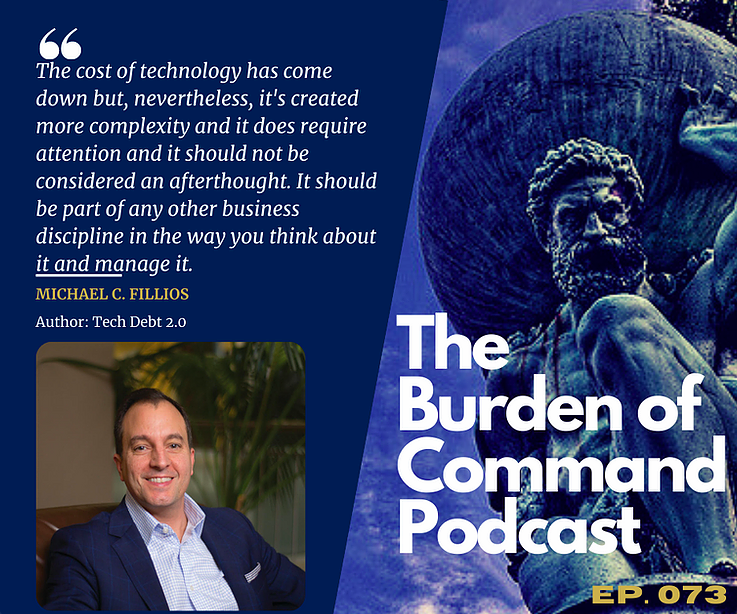Open-heart surgery prepped my SMB for the ultimate future proofing.
As a young executive, I received some sage advice from a career coach when discussing the topic of “work life balance.” The advice was simple, but the impact was significant and lifted a burden I was carrying for quite some time. My coach said, “don’t try to come up with a magic formula that allocates a percent to the time you allocate to work, family and yourself, but rather put 100% focus into anything that you do.” In other words, be fully present and commit to those areas individually and you will never feel the burden of work / life balance ever again. He was right!
The Mindset

This gave me a unique perspective and more importantly a mindset that I have applied ever since. This mindset was recently tested when I decided to become an entrepreneur again when I launched IT Ally in 2017. My first tour was 10 years during the 2000’s when I was Chief Solutions Officer at BTM Corporation. So as the saying goes, this was not my first rodeo. As my fellow entrepreneurs know, in the early stages of a starting your business, 100% of your success fully depends on the actions of the entrepreneur. You never feel you are doing enough, there is always more you want to accomplish, and it can never happen fast enough.
However, one additional shift in this case from my role as a Fortune 500 CIO, was on the personal side. Yes, I always worked hard regardless of the job or role I had, but as an entrepreneur, I knew exactly what it is was going to take, the sacrifices I needed to make and how that increased time would impact my work / life balance. With my career coach’s advice in mind, I made sure to apply the 100% percent formula. Being an entrepreneur, outside the structure of the corporate world, there was another dynamic – that is, there truly isn’t a bright line defining what is business versus personal time. My fellow entrepreneurs know this all too well – that line is never clear and tends to shift continuously. In fact, in my experience, it is in most cases nonexistent.
Open-Heart Surgery
In early January 2021, this struggle to define and separate business and personal was “big-time” tested when I learned that I needed to undergo open heart surgery to correct a known defect that afflicts about 1% of the population. The realization hit me when my cardiologist strongly recommended, I address this issue right away, when in my mind, I had about another ten years! Coming off of a record-setting 2020 for IT Ally Holdings and our operating companies, navigating the pandemic and the usual entrepreneurial stresses in an early-stage company, I worried about the impact this would have on my business, my personal life, my health, and my family. I also knew that I would need to apply a different plan and playbook to navigate this process, especially with a relatively compressed timeline of about two weeks before my surgery. I could not, for example, just go out on short term disability and let my corporate HR and benefits take care of the rest. So, let’s just say, we had more questions than answers in terms of getting prepared, not to mention major surgery that was looming!
Needless to say, I treated this situation like many others that I have done before, and became hyper focused on detailed planning and flawless execution at least for the pieces in my control. Oh did I mention, that I managed to schedule my surgery at the top cardiac hospital in the country, the Cleveland Clinic, so I knew that I would be in great hands for my procedure.
Personal Affairs
Although my surgery went as planned and I am in midst of my recovery process now, I wanted to share some of my experiences and lessons learned from a business and personal perspective that might be relevant to other entrepreneurs and business owners and in my case as a husband, father and grandfather, which again reinforced the blurred lines that exist from what is a business versus personal situation.
Getting your personal affairs in order. Having surgery thrust upon us so quickly, it was a great opportunity for my wife and me to update our legal and business documents such as wills, trusts, beneficiaries, insurance coverage, health care proxies, banking and investment portfolio. Having three kids over the age of 18, also meant that our conversations with them would need to be thoughtful and detailed, but hopefully without creating any major sense of panic. Fortunately, we had many of these documents in place, but our personal /business circumstances had changed since their creation and therefore required some significant updating and alignment with my newly formed businesses and financial situation.
Business Affairs

Getting your business affairs in order. Having created and launched 4 operating businesses and a holding company since 2017, it was important to revisit all operating agreements with our corporate attorney. We basically wanted to ensure that these agreements reflected our current ownership structure and aligned with the trust we established to ensure the assets were protected, estate taxes were mitigated and that the business had a clear path forward should I no longer be able to operate it. Although I had these conversations in my mind a thousand times, the process this time around was much more real and, in some cases, required difficult decisions to be made, but once addressed, felt like a major burden was lifted. Not to mention, I knew that my family and my business would be protected and we had a plan to operate from should the worst scenario play out.
Communicate
Communicate, communicate, communicate. We knew that we needed to communicate my situation, but wanted to be thoughtful and deliberate in terms of our message and timing for when and who to deliver it to. Like many transformational or significant projects that we assist our clients with, we needed a plan to manage this process and the various business and personal communications. As we contemplated the plan, it turned out to be a fairly comprehensive list that included my team, current and potential new clients, partners, children, family members, and close friends. Armed with this list, we defined, sequenced and executed a communications plan within the two week window and got the job done.
Trust
Trust your team, trust the process. Since the formation of IT Ally in 2017, I always viewed this as a scalable business rather than one that was centered just around me. Because of this strategy, I created a business and operating model to achieve this vision. In fact, one of our first podcasts, Inside the IT Ally Business Model, explained more about this.
Having to leave the “business office” for this surgery and with a lengthy and somewhat uncertain recovery period to follow, I was able to test or perhaps retest and validate this model given the reliance needed on my team to sustain our operations during this period. For example, our Monday staff meetings that we instituted some time ago, meant that the team was highly informed and aware of all current clients, new business opportunities and key strategies that we were pursuing.
From the beginning, I had also been very disciplined about taking a product management mentality in the way that we deliver our services. This enables repeatability, consistency and scalability of our services as well as a way to manage quality control over our deliverables. By having a defined set of packaged, and tool enabled services, we are also able to make our proposal pricing and client agreements more standardized and use these templates to streamline and simplify our client acquisition process.
Key Takeaways
Having navigated this harrowing experience for myself, I realized the lessons I’ve learned extend to my business and to SMBs who are my current and future clients. In many of our IT due diligence engagements, we often come across the topic of key man risk which in too many cases, highlights the dependency on one or a short list of a few key resources that have deep knowledge of the business, systems and typically a long history with the company.
Needless to say, whether this is the owner, executive, manager, or your administrative assistant, having a game plan for key members that you can’t live without” needs to be understood and comprehended in a plan. The plan should be formalized and communicated to those who are involved and should include documentation of passwords, procedures, practices, responsibilities, and confidential information essential to the business. Below are a few others to consider regardless of whether being brought on by a major surgery in my case or because you want to take stock in your business and personal affairs.
- You can never be prepared enough, but need to be aware of the implications and burden as an entrepreneur and the blurred lines between personal and business.
- You can’t do it all alone, rely on and trust your team and communicate with intent to all key parties including essential staff, clients, partners and other key stakeholders.
- Don’t underestimate the legal and tax side of things. This input and expertise are extremely valuable so make sure that you have trusted partners on your side.
- Don’t wait for a crisis to validate and pressure test your business and operating model. Plans should be subject to periodic review and adjustment
- Identify your “key man” risks as it relates to your business and put in place a contingency plan to prepare for the unexpected.




